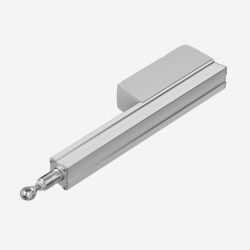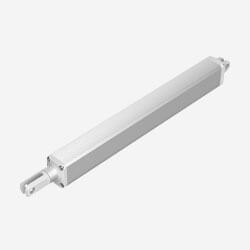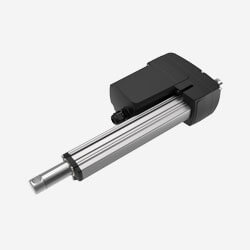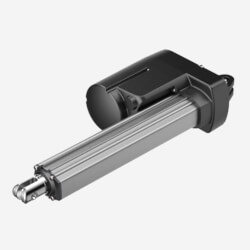févr. 18 2025
Avantages des vérins électriques linéaires dans les systèmes d'énergie renouvelable - Eoliennes
Actualités et articles
Electric Linear Actuators in Wind Energy: Optimizing Turbine Performance
As the world transitions to sustainable energy, wind turbines play a crucial role in energy generation. A key factor in maximizing their efficiency is the use of actuators, which control critical mechanical movements within the system. Among available options, electric linear actuators offer superior precision, energy efficiency, and environmental sustainability, making them a preferred choice over hydraulic and pneumatic alternatives.
Key Applications for Electric Linear Actuators in Wind Turbines
Electric actuators improve wind turbine performance by delivering precise and responsive mechanical movements. A case study by Windurance found that increasing rotor size and incorporating a pitch system can enhance annual energy production (AEP) by 40-60%, depending on wind conditions.
Primary applications include:
- Blade Pitch Control: Actuators precisely adjust blade angles to optimize aerodynamic efficiency, ensuring maximum energy capture among varying wind speeds.
- Nacelle Orientation: Actuators enable precise yaw adjustment, aligning the nacelle with wind direction to minimize mechanical strain and optimize power output.
- Ventilation Systems: TiMOTION’s VN1 and VN2 actuators mange airflow within the nacelle, preventing thermal buildup and enhancing component reliability.
- Turbine Tower Raising: Certain turbine designs incorporate actuators to assist in raising and stabilizing turbine towers during installation and maintenance.
Advantages of Electric Actuators Over Hydraulic and Pneumatic Systems
Electric linear actuators provide several advantages that make them superior to traditional systems:
- Reliability and Low Maintenance: Hydraulic actuators are prone to fluid leaks, which can lead to maintenance challenges and environmental concerns. In contrast, electric actuators eliminate the risk of fluid leakage, offering a cleaner and more durable alternative.
- Higher Energy Efficiency: Operating at 75-80% efficiency compared to 40-55% for hydraulic systems, electric actuators offer superior energy utilization, minimizing waste and improving overall system efficiency in continuous operation.
- Eco-Friendly Solution: Hydraulic systems in wind turbines risk fluid leaks, which can contaminate soil and groundwater. A study by the Agency for Toxic Substances and Disease Registry confirms these risks, while a 2014 investigation at the Ocotillo Wind Facility found leaks in over 40% of its turbines. Electric actuators eliminate these concerns by removing the need for hydraulic fluids.
- Precision and Accuracy: Some electric actuators offer positioning accuracy up to ±0.000315 inches, making them ideal for applications requiring precise movement.
- Cost-Effectiveness: Designed for specific load and speed requirements, electric actuators avoid excessive engineering often associated with hydraulic systems, lowering costs.
- Reduced Noise Levels: Electric actuators operate more quietly than hydraulic and pneumatic counterparts, making them ideal for noise-sensitive environments.
- Immediate Force Output: Unlike hydraulic actuators that require pressure buildup, electric actuators generate force instantly, improving response times.
Market Trends and Growth
The demand for electric linear actuators is rising. In 2022, the global market was valued at $20.5 billion and is expected to grow at a compound annual growth rate (CAGR) of 5.3%, reaching $34.3 billion by 2032.
Conclusion
Electric linear actuators are redefining wind turbine technology by offering improved reliability, energy efficiency, and precision. TiMOTION’s MA and VN series actuators offer cutting-edge solutions for wind energy, ensuring durability, precision, and efficiency in critical applications.
- MA2 & MA3: Heavy-duty actuators with high load capacities (up to 16,000N) and real-time feedback capabilities for optimized control.
- MA6: Designed for durability with an IP68 rating and precise synchronization technology.
- VN1 & VN2: Ventilation actuators ensuring efficient airflow management, with IP66 protection and Hall sensor feedback for reliability.
By integrating electric actuators, turbine operators can achieve greater efficiency, lower maintenance costs, and contribute to a more sustainable energy future.
Electric linear actuators are redefining wind turbine technology by offering improved reliability, energy efficiency, and precision. TiMOTION’s lineup, including the MA2, MA3, MA6, VN1, and VN2 models, provides advanced solutions tailored for wind energy applications. By integrating electric actuators, turbine operators can achieve greater efficiency, lower maintenance costs, and contribute to a more sustainable energy future.















